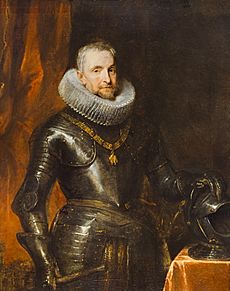Palatinate campaign facts for kids
Quick facts for kids Palatinate campaign |
|||||||
|---|---|---|---|---|---|---|---|
| Part of the Thirty Years' War | |||||||
|
|||||||
| Belligerents | |||||||
| Spanish Empire | Protestant Union | ||||||
| Commanders and leaders | |||||||
| Strength | |||||||
| Imperial army | |||||||
The Palatinate campaign was a major military event during the Thirty Years' War. It took place from August 1620 to August 1623. This campaign involved the Imperial army fighting against the Protestant Union in a region called the Lower Palatinate in what is now Germany. It is also known as the Spanish conquest of the Palatinate.
Contents
Understanding the Thirty Years' War
The Thirty Years' War started in 1618. It was a big conflict in Europe, mainly about religion and power. The war began when a group of Protestant nobles in Bohemia chose Frederick of the Palatinate as their king. They did this instead of accepting the Catholic Emperor Ferdinand II.
Why the Palatinate Campaign Started
At first, many parts of the Empire stayed out of the fight. They saw it as a disagreement over who should inherit the Bohemian throne. However, the revolt was quickly put down. But neither Frederick nor Ferdinand wanted to give up. So, the Imperial forces decided to invade the Palatinate. This move changed the war from a local dispute to a much bigger conflict.
Who Else Joined the Conflict?
Other Protestant countries became involved. James VI and I, who was the king of England and Scotland, joined in. His daughter, Elizabeth, was married to Frederick. Protestant states within the Empire also felt threatened.
Even countries outside the Empire with lands inside it got involved. For example, the Dutch Republic had control over Nassau-Dillenburg. Also, Christian IV of Denmark was the Duke of Holstein. The war also happened as a peace agreement between the Dutch Republic and Spain was ending. This gave France a chance to act, as they were dealing with their own internal rebellions supported by Spain.
Key Events of the Campaign
The Palatinate campaign began in August 1620. Ambrogio Spinola led an Imperial army of 24,000 soldiers into the Lower Palatinate. They quickly captured several important cities. By October 1st, they had taken Kreuznach, Oppenheim, and Bacharach. They also occupied the Bergstrasse district.
Major Sieges and Battles
In August 1621, the city of Mainz fell to Spanish forces. Spinola then began a siege of Jülich. Jülich surrendered in February 1622. This was important because it cut off the supply route between the Dutch Republic and the Upper Palatinate.
In March, the army of the Catholic League, led by Tilly, invaded from Bavaria. Protestant forces, led by the Margrave of Baden-Durlach and Mansfeld, tried to stop them. This led to the Battle of Mingolsheim on April 27, which had no clear winner.
Mansfeld then moved to Ladenburg. The Margrave chased the Bavarians. However, he didn't know that Tilly had joined forces with another Spanish commander. On May 8, the Margrave was defeated at the Battle of Wimpfen. After this, fighting stopped for a while because of widespread disease.
The Fall of Key Cities
By early November, Imperial-Spanish forces captured Heidelberg and Mannheim. These were the two most important cities in the Lower Palatinate. Frederick, the leader of the Protestants, had to flee. He went into exile in the United Provinces.
The Spanish army took control of the western part of the Palatinate. This helped them control a key travel route called the Spanish Road. Maximilian of Bavaria took the rest of the region.
The End of the Campaign
The Protestant army in the Palatinate had many volunteers from different countries. This included several English regiments led by Sir Horace Vere. These troops were left alone after the Protestant defeats. In March 1623, King James told them to surrender. This marked the end of the Palatinate campaign.
What Happened Next
King James had hoped that surrendering would lead to a deal with Philip IV of Spain. He wanted Frederick to get his lands back. But this did not happen. In February 1623, Emperor Ferdinand removed Frederick as one of the seven Imperial Prince-electors. This meant Frederick lost his important vote, which then went to Maximilian of Bavaria.
On August 6, Tilly defeated another Protestant army. This army was led by Christian of Brunswick at the Battle of Stadtlohn. After this, Frederick signed a peace agreement with Ferdinand. This officially ended the "Palatine Phase" of the Thirty Years' War.
Ferdinand declared Bohemia to be a permanent possession of his family, the Habsburgs. He also took land from the Protestant nobles who had started the revolt. He then began a Catholic Counter-Reformation, trying to bring people back to the Catholic Church. These actions meant the war would continue. In 1624, many countries formed an alliance against the Habsburgs. These included England, France, the Dutch Republic, Sweden, Denmark-Norway, the Duchy of Savoy, the Republic of Venice, and Brandenburg.
See also
 In Spanish: Campaña del Palatinado para niños
In Spanish: Campaña del Palatinado para niños


